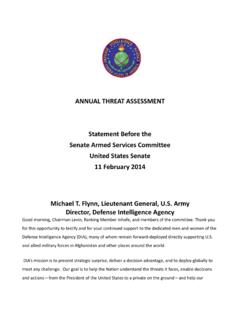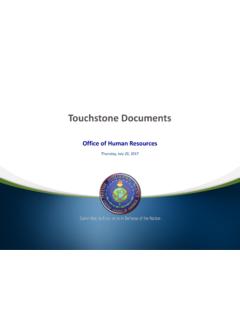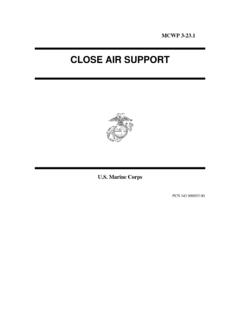Transcription of INTENTIONALLY LEFT BLANK
1 2019 This report is available online at media and public inquiries about this report, contact more information about the Defense Intelligence Agency, visit DIA's website at cutoff date, November image, Navy frigate Yantai of the 11th Chinese naval escort flotilla. Source: LEFT BLANKIVPREFACEIn September 1981, Secretary of Defense Caspar Weinberger asked the Defense Intelligence Agency to produce an unclassified overview of the Soviet Union s military strength. The purpose was to provide America's leaders, the national security community, and the public a comprehensive and accurate view of the threat. The result: the first edition of Soviet Military Power. DIA produced over 250,000 copies, and it soon became an annual publication that was translated into eight languages and distributed around the world. In many cases, this report conveyed the scope and breadth of Soviet military strength to policymakers and the public for the first the spirit of Soviet Military Power, DIA began in 2017 to produce a series of unclassified Defense Intelligence overviews of major foreign military challenges we face.
2 This volume provides details on China s defense and military goals, strategy, plans, and intentions; the organization, structure, and capability of its military supporting those goals; and the enabling infrastructure and industrial base. This product and other reports in the series are intended to inform our public, our leaders, the national security community, and partner nations about the challenges we face in the 21st MILITARY POWERM odernizing a Force to Fight and WinDEFENSE INTELLIGENCE AGENCYVThe Defense Intelligence Agency indeed the broader Intelligence Community is continually asked, "What do we need to know about China?" What is China s vision of the world and its role in it? What are Beijing s strategic intentions and what are the implications for Washington? How are the PLA s roles and missions changing as it becomes a more capable military force?
3 Since Mao Zedong s Communist Revolution in October 1949 brought the Chinese Communist Party to power, China has struggled to identify and align itself with its desired place in the world. Early factional struggles for control of party leadership, decades of negotiations to define territorial boundaries, and continued claims to territories not yet recovered have at times seemed at odds with the self-described nature of the Chinese as peace-loving and oriented only toward their own defense. Chinese leaders historically have been willing to use military force against threats to their regime, whether foreign or domestic, at times preemptively. Lack of significant involvement in military operations during the last several decades has led to a sense of insecurity within the PLA as it seeks to modernize into a great power military.
4 Still, the United States has at times found itself in direct conflict with China or Chinese forces. China supported two major conflicts in Asia after the Second World War, introducing Chinese volunteer forces in Korea and providing direct Chinese air and air defense support to Hanoi in Vietnam. In addition, China fought border skirmishes with the Soviet Union, India, and a unified Vietnam. In all three cases, military action was an integral part of Chinese diplomatic negotiations. Since then, China has concluded negotiations for most of its land borders (India and Bhutan being the outliers) but remains in contention with Japan, the Philippines, Brunei, Indonesia, Malaysia, and Vietnam over maritime borders, which may in part explain motivation for the PLA Navy s impressive growth and the new emphasis on maritime law enforcement s double-digit economic growth has slowed recently, but it served to fund several successive defense modernization Five-Year Plans.
5 As international concern over Beijing's human rights policies stymied the PLA s search for ever more sophisticated technologies, China shifted funds and efforts to acquiring technology by any means available. Domestic laws forced foreign partners of Chinese-based joint ventures to release their technology in exchange for entry into China s lucrative market, and China has used other means to secure needed technology and expertise. The result of this multifaceted approach to technology acquisition is a PLA on the verge of fielding some of the most modern weapon systems in the world. In some areas, it already leads the leaders characterize China s long-term military modernization program as essential to achieving great power status. Indeed, China is building a robust, lethal force with capabilities spanning the air, maritime, space and information domains which will enable China to impose its will in the region.
6 As it continues to grow in strength and confidence, our nation s leaders will face a China insistent on having a greater voice in global interactions, which at times may be antithetical to interests. With a deeper understanding of the military might behind Chinese economic and diplomatic efforts, we can provide our own national political, economic, and military leaders the widest range of options for choosing when to counter, when to encourage, and when to join with China in actions around the report offers insights into the modernization of Chinese military power as it reforms from a defensive, inflexible ground-based force charged with domestic and peripheral security responsibilities to a joint, highly agile, expeditionary, and power-projecting arm of Chinese foreign policy that engages in military diplomacy and operations across the 2015 Chinese white paper China s Military Strategy, issued by China s State Council Information Office, states.
7 It is a Chinese Dream to achieve the great rejuvenation of the Chinese nation. The Chinese Dream is to make the country a strong military, a country can neither be safe nor strong. Robert P. Ashley, General, Army DirectorDefense Intelligence AgencyINTENTIONALLY LEFT BLANKCHINA MILITARY POWERM odernizing a Force to Fight and WinDEFENSE INTELLIGENCE AGENCYVIICONTENTSI ntroduction/Historical Overview .. 11978 Present: China s Military Rise ..2 National Military Overview .. 7 Threat Perceptions ..7 National Security Strategy .. 12 The PLA s Role in National Security .. 13 Military Leadership.. 13 Stability Issues .. 17 External Defense Relations .. 19 Defense Budget .. 20 Military Doctrine and Strategy ..23 Perceptions of Modern Conflict .. 24 National Military Command and Control ..25 Core Elements of Command and Control Reform 25 Modernizing Joint Command and Control 27 Regional and Global Operations.
8 28 Core Chinese Military Capabilities ..31 Power Projection and Expeditionary Operations .. 33 Nuclear Forces and Weapons .. 36 Biological and Chemical Warfare .. 39 Space/Counterspace .. 40 Satellites 41 Counterspace 43 Human Spaceflight and Space-Exploration Probes 43 Space Launch 44 VIIIC yberspace ..45 Denial and Deception .. 46 Logistics and Defense-Industrial Modernization .. 47 Logistics 47 Defense-Industrial Base 48 Underground Facilities.
9 50 Missions Other Than War ..50 Outlook: Developing a Robust Force ..52 APPENDIX A: PLA Army ..55 APPENDIX B: PLA Navy ..63 APPENDIX C: PLA Air Force ..83 APPENDIX D: PLA Rocket Force ..91 APPENDIX E: PLA Strategic Support Force ..97 APPENDIX F: Chinese Intelligence Services ..99 APPENDIX G: Military Resources, Infrastructure, and Logistics ..101 APPENDIX H: Defense Industry .. 105 APPENDIX I: Arms Sales .. 107 APPENDIX J: Glossary of Acronyms.. 109 INTENTIONALLY LEFT BLANKINTENTIONALLY LEFT BLANKCHINA MILITARY POWERM odernizing a Force to Fight and WinDEFENSE INTELLIGENCE AGENCY1 Introduction/Historical Overviewhina s history dates back nearly five millennia. Historians credit the armies of numerous dynasties throughout those many centuries with unifying the early warring states, building the Great Wall, send-ing the fleets of early Ming Dynasty maritime explorer Zheng He to far-off foreign lands, and defending against foreign incursions.
10 However, the People s Liberation Army (PLA) has existed for less than a century. Initially referred to as the Red Army under Mao Zedong, the PLA is not a national institution but rather the mil-itary arm of the Chinese Communist Party (CCP). Established in 1927, the army spent much of its first two decades engaged in fight-ing the Nationalists led by Chiang Kai-shek CPLA honor Source: DIMOCWith more than 5,000 years of civilized history, the Chinese nation created a brilliant Chinese civilization, made outstanding contributions to mankind, and became a great nation of the world. Chinese President Xi Jinping12during the intermittent Chinese Civil War as well as fighting against the Japanese during World War II (which China refers to as the War of Resistance Against Japan).Mao s Red Army declared victory over the Nationalists in October 1949, even as combat continued.












